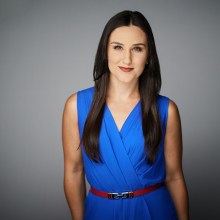SIMONE DEL ROSARIO:
THIS WEEK T-D BANK AGREED TO PAY MORE THAN $1.2 BILLION TO SETTLE A CASE INVOLVING A 7 BILLION DOLLAR PONZI SCHEME. THE CANADIAN BANK SAYS IT DIDN’T DO ANYTHING WRONG, BUT WANTS TO AVOID THE “DISTRACTION” OF A LONG LEGAL FIGHT. WE’VE GOT SOME OF THE MOST FASCINATING PONZI SCHEMES IN HISTORY IN THIS WEEK’S FIVE FOR FRIDAY.
CHARLES PONZI WAS FAR FROM THE FIRST TO BORROW FROM PETER TO PAY PAUL BUT THEY SLAPPED HIS NAME ON THE SCHEME ANYWAY. IN 1920 PONZI LURED INVESTORS BY OFFERING 50% INTEREST IN JUST 90 DAYS BY BUYING AND SELLING INTERNATIONAL POSTAL REPLY COUPONS. HE PAID OFF EARLY INVESTORS USING MONEY FROM NEW INVESTORS, RAKING IN $15 MILLION IN JUST 8 MONTHS. THAT’S A WHOPPING $232 MIL TODAY. IN THE END HE WENT TO PRISON, GOT PAROLED, COMMITTED MORE FRAUD, WENT BACK TO PRISON AND EVENTUALLY DEPORTED TO HIS NATIVE ITALY.
HE DIDN’T JUST LAUNCH BOY BAND BEHEMOTHS N’SYNC AND THE BACKSTREET BOYS, BILKING THEM OUT OF MONEY. LOU PEARLMAN ALSO RAN A DECADES-LONG PONZI SCHEME. HE’D GET PEOPLE TO INVEST IN COMPANIES THAT ONLY EXISTED ON PAPER, CREATING FAKE FINANCIAL STATEMENTS TO SELL THEM ON IT. HE RAKED IN $300 MILLION BUT THE FEDS EVENTUALLY CAUGHT ON AND HE WAS ARRESTED AND SENTENCED TO 25 YEARS IN PRISON. HE DIED 8 YEARS LATER.
SOMETIMES PEOPLE WIN SETTLEMENTS IN COURT THAT PAY OUT OVER TIME AND THEY CAN’T ALWAYS WAIT TO COLLECT. THERE’S LEGITIMATE BUSINESS BEHIND THIS THAT GIVES THEM ACCESS TO A SMALLER LUMP SUM, KIND OF LIKE THE LOTTERY. BUT ATTORNEY SCOTT ROTHSTEIN CORRALLED INVESTORS TO PAY A LUMP SUM, PROMISING THEY’D REEP THE BENEFITS OF THE LARGER ANNUITY IN THE END. PROBLEM WAS, THE CASES NEVER EXISTED – ROTHSTEIN FORGED ALL THE DOCS. HE WAS EVENTUALLY CAUGHT AND SENTENCED TO 50 YEARS FOR RUNNING THE $1.2 BILLION SCHEME.
TEXAS BILLIONAIRE ALLEN STANFORD’S $7 BILLION SCAM INVOLVED CDs WITH FANTASTIC, “SAFE” RETURNS SOLD OUT OF HIS BANK IN ANTIGUA. BETTER THAN YOU COULD GET ANYWHERE ELSE. PONZI SCHEME ALERT! WHILE STANFORD INSISTED THE CDs WERE BACKED BY ACTUAL ASSETS, THE SEC SAID IT WAS A FRONT TO FUND HIS LAVISH LIFESTYLE. HE’S NOW SERVING 110 YEARS IN PRISON AS GOVERNMENTS TRY TO MAKE HIS INVESTORS WHOLE, HENCE TD BANK FORKING OVER $1.2 BILLION TO SETTLE THE MATTER.
BERNIE MADOFF’S $20 BILLION PONZI SCHEME IS ONE FOR THE HISTORY BOOKS… AND DOCS, MOVIES, AND TV. AS IS GENERALLY THE CASE, HE TOOK IN MONEY PROMISING HUGE RETURNS. BUT JUST DUMPED THE $20 BILLION INTO AN ACCOUNT HE USED AS HE PLEASED, WHILE TELLING INVESTORS THE RETURNS WERE WORTH 65 BIL. THE SCHEME FELL APART WHEN THE MARKET CRASHED IN 2008 AND HE COULDN’T PAY ANYONE OUT. HE WAS SENTENCED TO 150 YEARS AFTER HIS SONS TURNED HIM IN. HE DIED IN PRISON TWO YEARS AGO.
UNFORTUNATELY, VICTIMS MAY ONLY FIND SOLACE IN THE JAIL TIME SERVED BY THESE SCAMMERS, AS IT’S GOTTEN HARDER AND HARDER TO RECOUP THE STOLEN FUNDS. THAT’S FIVE FOR FRIDAY. I’M SIMONE DEL ROSARIO. IT’S JUST BUSINESS.
SIMONE DEL ROSARIO: PRESIDENT JOE BIDEN IS FLEXING HIS VETO POWER FOR THE FIRST TIME IN HIS PRESIDENCY.
THIS – AFTER THE HOUSE AND SENATE VOTED TO BLOCK A BIDEN ADMINISTRATION RULE ON E-S-G INVESTING.
BUT THE VETO MIGHT NOT END THE FIGHT.
THE LABOR DEPARTMENT RULE IN QUESTION WOULD ALLOW RETIREMENT FUND MANAGERS TO CONSIDER FACTORS LIKE CLIMATE CHANGE WHEN PICKING INVESTMENTS – REVERSING A TRUMP-ERA RULE THAT RESTRICTED FIRMS TO ONLY CONSIDER HOW INVESTMENTS PERFORM.
REP. VIRGINIA FOXX: Due to Biden’s reckless economic policies too many Americans are worried about rising costs of living. Diverting retirement savings to fund social justice causes will make this problem even worse.
SIMONE DEL ROSARIO: CONSERVATIVES HAVE INCREASINGLY TARGETED SO-CALLED “WOKE” INVESTING, THAT IS: ENVIRONMENT, SOCIAL AND CORPORATE GOVERNANCE, KNOWN AS ESG.
SEN. CHUCK SCHUMER: Republicans talk about their love for the free market small government let the private sector do its work but their obsession with eliminating esg would do the opposite forcing their own views down the throats of every company and every investor 10:30}
SIMONE DEL ROSARIO: SUPPORTERS OF THE RULE ARGUE IT’S VOLUNTARY WHETHER FUND MANAGERS WANT TO LOOK AT ESG OR NOT.
BUT A BILL BLOCKING THE RULE NOT ONLY PASSED THE REPUBLICAN-CONTROLLED HOUSE, BUT CLEARED THE DEMOCRAT-CONTROLLED SENATE AS WELL.
TWO DEMOCRATS, JOE MANCHIN AND JON TESTER, SIDED WITH REPUBLICAN SENATORS. BOTH HAIL FROM RED STATES AND ARE UP FOR REELECTION IN 2024.
WHITE HOUSE PRESS SECRETARY KARINE JEAN-PIERRE: This is unacceptable to the president and that is why he will veto this bill if it comes to his desk.
SIMONE DEL ROSARIO: BUT EVEN WITH THE VETO PEN – THE RULE STILL FACES A BATTLE IN COURT. A COALITION OF REPUBLICAN-LED STATES HAS ASKED A FEDERAL JUDGE TO BLOCK IT, CLAIMING THE RULE WILL JEOPARDIZE RETIREMENT SAVINGS.
THE GOVERNMENT ARGUES IT WON’T, SAYING THE RULE STILL REQUIRES RETIREMENT PLANS TO PRIORITIZE FINANCIAL GAINS OVER ESG.
RIGHT NOW – BOTH SIDES ARE FIGHTING OVER WHERE THIS WILL BE HASHED OUT.
THE FEDERAL GOVERNMENT WANTS THE CASE MOVED FROM THE CURRENT AMARILLO, TEXAS, FEDERAL COURT, WHERE TRUMP-APPOINTED JUDGE MATTHEW KACSMARYK IS SEEN AS A ROADBLOCK TO BIDEN’S POLICIES. HE’S SO FAR HALTED FEDERAL ACTION ON ISSUES FROM ASYLUM SEEKERS TO BIRTH CONTROL.
RED STATES ARE REJECTING A CHANGE IN VENUE, ADDING A PLAINTIFF THIS WEEK FROM AMARILLO TO PROVE THE CASE BELONGS THERE.
I’M SIMONE DEL ROSARIO. IN NEW YORK IT’S JUST BUSINESS.
SIMONE DEL ROSARIO: THE SUPREME COURT IS SET TO REVIEW WHETHER AN ENTIRE FEDERAL AGENCY IS UNCONSTITUTIONAL.
THE FUTURE OF THE CONSUMER FINANCIAL PROTECTION BUREAU IS AT STAKE.
FIRST – WHAT IT IS.
THE C-F-P-B WAS BORN OUT OF THE 2008 FINANCIAL CRISIS. IT IS THE BRAINCHILD OF THEN-FUTURE SENATOR ELIZABETH WARREN. IN 2010, CONGRESS AND THEN-PRESIDENT BARACK OBAMA SIGNED THE DODD FRANK ACT WHICH CREATED THE BUREAU. IT CONSOLIDATED CONSUMER FINANCIAL PROTECTION AUTHORITY FROM SEVEN DIFFERENT AGENCIES UNDER ONE ROOF.
SOME OF THE BUREAU’S WINS INCLUDE:
EXPOSING THE WELLS FARGO FAKE ACCOUNTS SCHEME AND OTHER VIOLATIONS, FORCING THE BANK TO PAY BILLIONS IN FINES.
CRACKING DOWN ON RISKY MORTGAGE LENDING, THE CATALYST OF THE FINANCIAL CRASH.
AND RECOVERING $16 BILLION FOR CUSTOMERS SINCE ITS INCEPTION.
CRITICS OF THE BUREAU HAVE LONG ARGUED IT IS TOO POWERFUL, UNACCOUNTABLE AND BURDENSOME, LEVYING TOO MANY FINANCIAL REGULATIONS.
A PARTICULAR POINT OF ATTACK IS THE WAY THE BUREAU WAS STRUCTURED FROM THE BEGINNING.
DEMOCRATS INTENDED TO PROTECT THE BUREAU FROM POLITICAL PRESSURE IN TWO WAYS: ONE, THE SOLE AGENCY DIRECTOR COULD ONLY BE FIRED FOR CAUSE, AND TWO, THE AGENCY WOULD BE FUNDED THROUGH THE FEDERAL RESERVE, NOT CONGRESSIONAL APPROPRIATIONS.
THAT FIRST ONE WAS ALREADY CHALLENGED IN A 2020 SUPREME COURT RULING. THE COURT DETERMINED THE DIRECTOR’S REMOVAL PROTECTIONS WERE UNCONSTITUTIONAL, AND NOW THE BUREAU DIRECTOR SERVES AT THE PLEASURE OF THE PRESIDENT AND CAN BE FIRED AT WILL.
THE SECOND PART IS AT THE HEART OF THE CASE THE SUPREME HAS JUST DECIDED TO REVIEW.
THREE TRUMP-APPOINTED JUSTICES FROM THE 5TH CIRCUIT COURT OF APPEALS RULED IN OCTOBER THAT CFPB FUNDING GOES AGAINST THE CONSTITUTION BECAUSE IT BYPASSES CONGRESS, VIOLATING SEPARATION OF POWERS.
IT STEMMED FROM A LAWSUIT BY THE PAYDAY LENDING INDUSTRY, CHALLENGING A CFPB RULE THAT WOULD HAVE RESTRICTED THEIR ACCESS TO CUSTOMER BANK ACCOUNTS.
THE COURT RULED AGAINST THE BUREAU NOT BECAUSE OF A LACK OF AUTHORITY IN MAKING THAT RULE, BUT BECAUSE IT FINANCED ITS RULEMAKING VIA UNCONSTITUTIONAL FUNDING.
IF THIS DECISION IS UPHELD, IT COULD THROW INTO QUESTION EVERY RULE THE AGENCY HAS MADE IN ITS 12-YEAR HISTORY.
THE BIDEN ADMINISTRATION ASKED THE SUPREME COURT TO EXPEDITE THE REVIEW, BUT THE COURT DECIDED AGAINST FAST-TRACKING IT, SO A DECISION WON’T COME FOR ABOUT ANOTHER YEAR.
I’M SIMONE DEL ROSARIO IN NEW YORK IT’S JUST BUSINESS.
SIMONE DEL ROSARIO: STARTING MARCH FIRST, MILLIONS OF AMERICANS WILL HAVE LESS MONEY TO BUY GROCERIES.
ACROSS 32 STATES, DC AND SOME TERRITORIES – EMERGENCY SNAP BENEFITS ARE COMING TO AN END. IT’S ALREADY ENDED IN THE REST OF THEM.
FOR NEARLY THREE YEARS, THE FOOD STAMP PROGRAM HAS DISHED OUT CONGRESSIONALLY-ALLOCATED PANDEMIC-ERA INCREASES.
WITH EMERGENCY AID NOW ENDING, HOUSEHOLDS WILL GET AT LEAST $95 LESS PER MONTH, ACCORDING TO THE LEFT-LEANING THINK TANK, CENTER ON BUDGET AND POLICY PRIORITIES. SOME HOUSEHOLDS WILL SEE REDUCTIONS OF $250 OR MORE.
ACCORDING TO A REPORT BY THE LEFT-LEANING URBAN INSTITUTE: EMERGENCY ALLOTMENTS KEPT 4.2 MILLION PEOPLE OUT OF POVERTY THE LAST QUARTER OF 2021, REDUCING CHILD POVERTY BY 14% IN STATES WITH THE BENEFIT.
THE CUTOFF COMES AS GROCERIES ARE 11.3% HIGHER THAN ONE YEAR AGO. ANTI-HUNGER ADVOCATES SAY POVERTY RATES ARE NOW LIKELY TO RISE.
MEANWHILE, THE COST OF THE SNAP PROGRAM HAD SURGED UNDER THESE EMERGENCY PAYMENTS, FROM 60 BILLION IN FISCAL YEAR 2019 TO NEARLY 114 BILLION BY FISCAL YEAR 2021, THE FIRST FULL YEAR OF PANDEMIC BENEFITS.
NOT ALL PROGRAMS ARE COMING OFF THE TABLE. FAMILIES THAT QUALIFY CAN STILL GET A SUMMER BENEFIT FOR KIDS TO REPLACE MEALS THEIR SCHOOLS WOULD USUALLY PROVIDE.
BUT THE CONGRESSIONAL BUDGET OFFICE SAYS THE END OF OTHER EMERGENCY MEASURES WILL DROP THE SNAP COST BY $21 BILLION FOR FISCAL YEAR 2023.
SNAP IS ONE OF THOSE GOVERNMENT BENEFITS THAT ADDS MORE TO THE ECONOMY THAN IT COSTS TO MAINTAIN.
EVERY DOLLAR SPENT ON SNAP CONTRIBUTES ABOUT $1.50 TO THE GDP. THAT CAN HAVE AN EFFECT OF STIMULATING THE ECONOMY. AND THE REDUCTION OF BENEFITS, MIGHT SLIGHTLY DEPRESS ECONOMIC GROWTH AND INFLATION.
I’M SIMONE DEL ROSARIO. IN NEW YORK, IT’S JUST BUSINESS.
SIMONE DEL ROSARIO: WHEN IT COMES TO THE HOUSING MARKET – THERE ARE TWO WAYS TO LOOK AT THE LATEST HOME SALES DATA OUT MONDAY MORNING.
ONE IS THAT PENDING HOME SALES IS DOWN 24.1% YEAR OVER YEAR. NOT GREAT.
THE OTHER IS THAT PENDING HOME SALES IN JANUARY IS UP 8.1% FROM DECEMBER, RISING FOR THE SECOND CONSECUTIVE MONTH, AND WAY ABOVE EXPECTATIONS.
THIS FOLLOWS FRIDAY’S NEW HOME SALES RELEASE – WHICH WAS UP 7.2% FOR THE MONTH OF JANUARY.
SO WHAT’S BEHIND THIS RENEWED INTEREST IN HOUSING – WHICH IS SEEN SO FAR AS THE BIGGEST CASUALTY OF THE FEDERAL RESERVE’S RATE HIKE CAMPAIGN?
THE NATIONAL ASSOCIATION OF REALTORS SAYS BUYERS ARE RESPONDING TO BETTER AFFORDABILITY AND FALLING MORTGAGE RATES IN DECEMBER AND JANUARY, THOUGH THOSE ARE ALREADY BACK ON THE RISE.
BUT THERE’S A THIRD FACTOR THAT COULD BE BOOSTING *NEW HOME SALES, AT LEAST.
ALCYNNA LLOYD: We’ve seen demand creep back up a little bit but it’s still not at the levels we saw in 2020, and 2021. So what individual builders are doing right now, I’ve seen some builders offer more incentives.
SIMONE DEL ROSARIO: AND THE MAIN ONE – IS MORTGAGE BUYDOWNS.
IT’S ALWAYS BEEN A TOOL IN THE HOMEBUILDER’S BELT, BUT REALLY WASN’T NEEDED WITH RATES SO LOW.
NOW, WITH THE 30-YEAR AROUND 6.5%, HOMEBUILDERS ARE LURING IN BUYERS BY BUYING DOWN MORTGAGE RATES 1 TO 2 PERCENTAGE POINTS LOWER.
JOHN BURNS REAL ESTATE CONSULTING SAYS 75% OF SURVEYED HOMEBUILDERS AROUND THE COUNTRY CONFIRM THEY ARE BUYING DOWN MORTGAGE RATES TO MAKE PAYMENTS MORE AFFORDABLE.
32% ARE BUYING DOWN THE FULL 30-YEAR TERM, WHILE 30% ARE REDUCING THE RATE THE FIRST TWO YEARS.
THIS CAN COST THE HOMEBUILDER ANYWHERE FROM 2-6% OF THE SALES PRICE.
BUT WITH FEW RESALE SELLERS OFFERING THE SAME KIND OF DEAL, IT’S GIVING NEW HOMES A COMPETITIVE ADVANTAGE.
THE NAR STILL EXPECTS ANNUAL EXISTING HOME SALES TO DROP 11.1% IN 2023 – BEFORE JUMPING 17.7% IN 2024. WHILE NEW HOMES HAVE A MUCH ROSIER PICTURE. A 3.7% DROP AND A 19.4% RISE.
I’M SIMONE DEL ROSARIO. IN NEW YORK IT’S JUST BUSINESS.
SIMONE DEL ROSARIO:
ANTI-WOKE ENTREPRENEUR VIVEK RAMASWAMY JUST ANNOUNCED HE’S RUNNING FOR PRESIDENT IN 2024. THE 37 YEAR OLD HAS NEVER BEFORE BEEN ELECTED TO PUBLIC OFFICE, BUT HE DID FOUND A BIOTECH FIRM. WE’VE GOT SOME OTHER FOLKS WHO’VE TRIED TO MOVE FROM THE C-SUITE TO A SUITE IN THE WHITE HOUSE IN THIS WEEK’S FIVE FOR FRIDAY.
ANDREW YANG GOT A SURPRISING AMOUNT OF ATTENTION IN 2020 AFTER APPEARING ON HIGH PROFILE SHOWS AND PODCASTS. THE YANG GANG ENERGIZED HIS GRASSROOTS CAMPAIGN THROUGH MEMES AND SOCIAL MEDIA. ONE KEY PILLAR OF THE CEO’S CANDIDACY WAS A UNIVERSAL BASIC INCOME OF A THOUSAND BUCKS A MONTH. HE DIDN’T PICK UP MANY VOTERS THOUGH AND DROPPED OUT AFTER JUST TWO PRIMARIES, ENDORSING JOE BIDEN.
FORMER HP CEO CARLY FIORINA GAINED SOME MOMENTUM IN EARLY 2016 REPUBLICAN DEBATES. DESPITE BEING FORCED TO RESIGN AT HP IN 2005, SHE HOPED HER BUSINESS ACUMEN WOULD MAKE HER A STANDOUT. BUT LIKE YANG, SHE DROPPED OUT AFTER POOR SHOWINGS IN IOWA AND NEW HAMPSHIRE. SHE ALSO HAD THE SHORTEST V-P CANDIDACY IN MODERN HISTORY AFTER HITCHING HER WAGON TO TED CRUZ A WEEK BEFORE HE ENDED HIS CAMPAIGN.
IT MAY BE EASY TO FORGET ABOUT THE CANDIDACY OF TOM STEYER. THE HEDGE FUND MANAGER TURNED CLIMATE ACTIVIST RAN FOR THE DEMOCRATIC NOD IN 2020. STEYER SORT OF SURVIVED FOUR PRIMARIES BEFORE SUSPENDING HIS CAMPAIGN, AFTER EARNING ZERO DELEGATES AND SPENDING NEARLY A QUARTER OF A BILLION DOLLARS OF HIS OWN MONEY. BUT HE’S STILL WORTH 1 AND A HALF BILL, SO IT DIDN’T BREAK THE BANK.
THE 90S WERE WILD. AND BILLIONAIRE BUSINESSMAN ROSS PEROT’S DECADE WAS TOO. IN ‘92 PEROT LAUNCHED AN INDEPENDENT BID PITTING HIM AGAINST BILL CLINTON AND GEORGE H W BUSH. PEROT RAN ON BALANCING THE BUDGET, AND HEAVY OPPOSITION TO THE TRADE AGREEMENT KNOWN AS NAFTA. HE DIDN’T WIN ANY STATES BUT IS WIDELY SEEN AS ONE OF THE MOST SUCCESSFUL THIRD PARTY CANDIDATES OF ALL TIME GETTING 19% OF VOTES NATIONWIDE. HE ALSO SPAWNED ONE OF THE BEST SNL IMPRESSIONS OF ALL TIME {VOX POP: “CAN I FINISH.”} HE RAN AGAIN IN ‘96, BUT IT DIDN’T HAVE THE SAME JUICE.
FROM THE MOMENT REAL ESTATE MOGUL DONALD TRUMP DESCENDED ON A GOLDEN ESCALATOR – ANNOUNCING HIS 2016 CANDIDACY – HE WAS A GAME CHANGER. ON FULL DEBATE STAGES HE PUSHED THE BUTTONS OF ESTABLISHED POLITICIANS LIKE JEB BUSH AND MARCO RUBIO. HE RAN AWAY WITH THE NOMINATION AND SHOCKED PUNDITS BY DEFEATING HILLARY CLINTON IN THE GENERAL. HE LOST RE-ELECTION TO BIDEN IN 2020, HAS BEEN IMPEACHED TWICE BUT NOT REMOVED, AND IS RUNNING FOR A THIRD TIME IN 2024.
I THINK YA SAW THE LAST ONE COMING. AND UNFORTUNATELY THERE’S JUST NOT ENOUGH SLICES IN FIVE FOR FRIDAY FOR STEVE FORBES OR FORMER GODFATHER’S PIZZA CEO HERMAN CAIN. ALRIGHT, WE’LL SEE YOU NEXT WEEK, I’M SIMONE DEL ROSARIO. IT’S JUST BUSINESS.
SIMONE DEL ROSARIO: WITH $39 BILLION IN MANUFACTURING GRANTS UP FOR GRABS, THE RACE IS ON TO GET A PIECE OF THE CHIPS ACT.
{GINA RAIMONDO | COMMERCE SECRETARY}
{9:24 Folks, the stakes couldn’t be higher, could not be higher, which is why we have to win.
So next week, next Tuesday, I’ll be launching the first application for chips funding.}
COMMERCE SECRETARY GINA RAIMONDO LIKENED THE CHIPS RACE AND THE INNOVATION SHE HOPES IT SPURS TO KENNEDY’S SPACE RACE.
{september 12, 1962}
{John F. Kennedy}
{this is public domain, you don’t need to worry about credit}
{9:03 We choose to go to the moon in this decade and do the other things, not because they are easy, but because they are hard 9:11}
{8:08 This is so much more than incentivizing the creation of a few new semiconductor fabs around the country.}
BUT PRACTICALLY, HER PLAN THIS DECADE IS TO GET TWO NEW CLUSTERS OF CHIP MANUFACTURING BUILT IN THE U-S.
IT SEEMS LIKELY ONE OF THEM – WILL BE IN ARIZONA, WHERE COMPANIES LIKE INTEL AND TAIWAN’S TSMC HAVE PLEDGED TENS OF BILLIONS FOR NEW FABS.
{21:25 everyone’s gonna want to know next Tuesday, lot of members of the press here how much money is Intel getting how much money Samsung getting? I don’t want to talk about that.}
WHILE THE SEMICONDUCTOR INDUSTRY PULLED TOGETHER TO PUSH THE HISTORIC TAXPAYER INVESTMENT – IT’S NOW STARTING TO SPLINTER AS THE BIDEN ADMINISTRATION PREPARES TO DIVVY UP THE FUNDS.
ACCORDING TO A NEW YORK TIMES ARTICLE, A PUBLIC RELATIONS FIRM ACCUSED INTEL OF ANGLING TO WIN SUBSIDIES TO BUILD FACTORIES THAT’LL SIT EMPTY, WAITING FOR DEMAND. THE FIRM DECLINED TO NAME THEIR CLIENT.
FOR ITS PART, INTEL, WHICH HAS HOSTED PRESIDENT BIDEN AT ITS OHIO SITE, HAS PUBLICLY QUESTIONED HOW MUCH TAXPAYER MONEY SHOULD GO TO NON-U-S COMPANIES LIKE TSMC OVER AMERICAN COMPANIES LIKE INTEL, WHICH IS HEADQUARTERED IN CALIFORNIA.
{I expect there will be many disappointed companies who feel that they should have a certain amount of money. The reality is the return on our investment here is the achievement of our national-security goal. – GINA RAIMONDO, COMMERCE SECRETARY}
RAIMONDO TOLD REPORTERS THIS WEEK SHE EXPECTS THERE WILL BE MANY DISAPPOINTED COMPANIES WHO FEEL THAT THEY SHOULD HAVE A CERTAIN AMOUNT OF MONEY.
WHILE CRITICS POINT OUT WITH SO MUCH TAXPAYER MONEY ON THE LINE, THE PRESSURE IS ON TO MAKE SURE THE FUNDS ARE PROPERLY USED.
I’M SIMONE DEL ROSARIO, IN NEW YORK IT’S JUST BUSINESS.
SHANNON LONGWORTH: THESE DAYS, EVERYBODY HAS A PODCAST.
APPARENTLY, EVEN A CANADIAN POLICE FORCE DOES.
IN A TIME WHEN POLICING IS HIGHLY SCRUTINIZED, THE TORONTO POLICE SERVICE SAYS IT’S GIVING THE COMMUNITY A BEHIND-THE-SCENES VIEW OF ITS ACTIVITIES.
THE SERIES—24 SHADES OF BLUE—IS CONTROVERSIAL BECAUSE THEY’VE SPENT MORE THAN $300,000 TO PRODUCE IT WITH A THIRD-PARTY, ACCORDING TO A CBC TORONTO INVESTIGATION. THIS COMES AS THE POLICE SERVICE JUST RECEIVED A BUDGET BUMP OF 48.3 MILLION DOLLARS TO IMPROVE RESPONSE TIMES AND HIRE MORE COMMUNITY SAFETY OFFICERS.
SOME ONLINE ARE WONDERING WHY TPS IS SPENDING THAT MUCH MONEY ON THE PODCAST, CALLING THE PROJECT “COPAGANDA.”
IN THE FIRST EPISODE, FROM 2020, A HOST SAYS HE INTENDS TO SHOW MORE OF THE JOB THAT’S NOT REPRESENTED IN TRADITIONAL MEDIA.
JAMES RAMER: “SYSTEMIC RACISM EXISTS. IT EXISTS IN EVERY INSTITUTION. IT EXISTS IN POLICING. AND THE FIRST STEP IN CHANGING IS UNDERSTANDING THAT AND RECOGNIZING IT. AND WE DO AND WE’RE SORT OF WORKING TOWARDS THAT. BUT AT THE SAME TIME WE ALSO HAVE A WHOLE GROUP OF PEOPLE—AN ENTIRE ORGANIZATION—THE VAST MAJORITY OF WHICH HAVE A GENUINE AND SINCERE COMMITMENT TO THE PROFESSION AND THEY ARE DOING GOOD WORK.”
SHANNON LONGWORTH: TENSION BETWEEN POLICE OFFICERS AND THE COMMUNITIES THEY PATROL HAVE BEEN ESPECIALLY HIGH SINCE GEORGE FLOYD’S DEATH—NOT ONLY HERE IN THE US, BUT IN CANADA AS WELL.
AND WHILE AN IPSOS POLL SHOWED 51% OF THE CANADIAN POPULATION SUPPORTED DEFUNDING THE POLICE IN 2020…NOT ONE CITY POLICE DEPARTMENT THERE HAS DONE SO, ACCORDING TO CONCORDIA UNIVERSITY PROFESSOR TED RUTLAND. HE SAYS THEIR BUDGETS HAVE ONLY GONE UP.
WHETHER THIS PODCAST IS EFFECTIVE IN REPAIRING RELATIONS IN TORONTO IS UNCLEAR. BUT THE SHOW CONTINUES, AS THE FORMER CHIEF SIGNED A THREE-YEAR CONTRACT EXTENSION IN 2021.
SIMONE DEL ROSARIO: THE MORMON CHURCH IS IN SOME MONEY TROUBLE FOR ALLEGEDLY HIDING JUST HOW MUCH IT HAS.
THE SECURITIES AND EXCHANGE COMMISSION HAS FINED THE CHURCH OF JESUS CHRIST OF LATTER-DAY SAINTS – AND ITS INVESTMENT PORTFOLIO MANAGER ENSIGN PEAK ADVISORS – FIVE MILLION BUCKS.
THE SEC SAYS THAT WITH THE CHURCH’S APPROVAL, ENSIGN CREATED 13 SHELL CORPORATIONS TO HIDE THE CHURCH’S BILLIONS SO IT WOULDN’T BE TIED BACK TO THE INSTITUTION.
THE SEC CLAIMS THE CHURCH WAS CONCERNED ABOUT THE PUBLIC FINDING OUT ITS INVESTMENT PORTFOLIO HAD GROWN TO NEARLY $38 BILLION BY 2020.
THAT’S ROUGHLY THE SIZE OF HARVARD’S ENDOWMENT THE SAME YEAR.
IN 2020, THE HEAD OF ENSIGN TOLD THE WALL STREET JOURNAL HE BELIEVED CHURCH LEADERS WERE CONCERNED *THAT KNOWLEDGE WOULD DISCOURAGE TITHING.
ACCORDING TO THE LDS CHURCH’S OFFICIAL WEBSITE, MEMBERS MUST GIVE 10% OF THEIR INCOME TO THE CHURCH, WHERE A COUNCIL THEN DECIDES HOW TO USE THE “SACRED FUNDS,” CLAIMING IT’S ALWAYS USED FOR THE LORD’S PURPOSE.
THE SEC SAYS THE CHURCH’S INVESTMENT MANAGER, WITH THE CHURCH’S KNOWLEDGE, WENT TO GREAT LENGTHS TO AVOID DISCLOSING THE CHURCH’S INVESTMENT.
THE CHURCH SAYS IN A STATEMENT THEY RELIED UPON LEGAL COUNSEL WHEN SIGNING OFF ON THE SHELL CORPORATIONS…AND NOW CONSIDER THIS MATTER CLOSED.
I’M SIMONE DEL ROSARIO IN NEW YORK IT’S JUST BUSINESS.
MATTHEW SCHRUERS: Section 230 has been a cornerstone rule for the Internet.
MICHAEL KARANICOLAS: The most important law in tech, the law that created the modern internet.
SIMONE DEL ROSARIO: THIS WEEK – THE SUPREME COURT IS LOOKING AT WHETHER TO NARROW SECTION 230 – THIS FOUNDATIONAL INTERNET SHIELD LAW THAT PASSED IN 1996. BUT EVEN SOME OF THE JUSTICES ARE GRAPPLING WITH THAT ROLE.
JUSTICE ELENA KAGAN: I mean, we’re a court, we really don’t know about these things. You know, these are not like the nine greatest experts on the internet.
SIMONE DEL ROSARIO: BUT EXPERTS SAY WHAT THEY DECIDE COULD DRAMATICALLY DISRUPT THE INTERNET.
MICHAEL KARANICOLAS: If Section 230 were to disappear overnight, I think there are very real questions about whether a company, even the size of Google or Facebook would be viable, without really radical changes to how their user interface works.
SIMONE DEL ROSARIO: MICHAEL KARANICOLAS IS THE EXECUTIVE DIRECTOR OF UCLA’S INSTITUTE FOR TECHNOLOGY LAW AND POLICY.
MICHAEL KARANICOLAS: I would far rather this be dealt with as a legislative matter. And I was actually very concerned when I saw that this was coming before the Supreme Court.
SIMONE DEL ROSARIO: THE TWO CASES AGAINST GOOGLE AND TWITTER ARE BROUGHT BY FAMILIES OF VICTIMS KILLED IN SEPARATE TERROR ATTACKS.
THEY’VE CHALLENGED THE TECH COMPANIES’ LEGAL IMMUNITY UNDER SECTION 230: THE LAW THAT SAYS COMPANIES ARE NOT LIABLE FOR WHAT OTHERS POST ON THEIR SITES, WHILE ALSO ALLOWING PLATFORMS TO MODERATE CONTENT WITHOUT FEAR OF LIABILITY.
MATTHEW SCHRUERS: So much of the digital economy turns on the ability of services to moderate their ecosystems without the risk of legal peril for whichever needle they miss in the haystack.
SIMONE DEL ROSARIO: BUT THE FAMILIES IN THESE CASES ARGUE THE PLATFORMS SHOULD BE HELD LIABLE FOR ALLOWING TERRORIST CONTENT THAT MAY HAVE HELPED RADICALIZE THE ATTACKERS. IN GOOGLE’S CASE, THE PLAINTIFFS’ LAWYERS ARGUED YOUTUBE IS ACTING AS A PUBLISHER BY RECOMMENDING MORE TERRORIST-RELATED VIDEOS, AND PUBLISHERS WOULD BE LEGALLY RESPONSIBLE.
MATTHEW SHRUERS, PRESIDENT OF COMPUTER & COMMUNICATIONS INDUSTRY ASSOCIATION, SAYS THERE ARE TWO WAYS THE INTERNET COULD RESPOND TO LEGAL LIABILITY.
MATTHEW SCHRUERS: You’ll have two different experiences, either the kindergarten, Sesame Street experience, or the chaotic Bourbon Street experience, right, either over moderated or under moderated. And neither experience is what internet users or advertisers want.
MICHAEL KARANICOLAS: Meaningful, individualized review, is simply not possible at that kind of scale, even for a company with the resources of Google or Facebook.
SIMONE DEL ROSARIO: WHICH IS WHY TECH LAWYERS ARGUE IT’S MORE LIKELY THE INTERNET WOULD GO THE OTHER DIRECTION AND AVOID MODERATION.
MATTHEW SCHRUERS: The worst case scenario would be a legal ruling that disincentivizes companies or encourages companies, not to police content online, and that in turn leaves users at greater risk of dangerous content.
SIMONE DEL ROSARIO: THE INTERNET HANGING IN THE BALANCE, SEVERAL JUSTICES SUGGESTED THIS QUANDARY MIGHT BE A BETTER CASE FOR CONGRESS.
TO FIND OUT MORE, SEARCH SECTION 230 ON STRAIGHT ARROW NEWS FOR MY PREVIOUS STORY WHICH GOES INTO MORE DETAIL ON THE FACTS OF THESE CASES.
I’M SIMONE DEL ROSARIO IN NEW YORK IT’S JUST BUSINESS.











